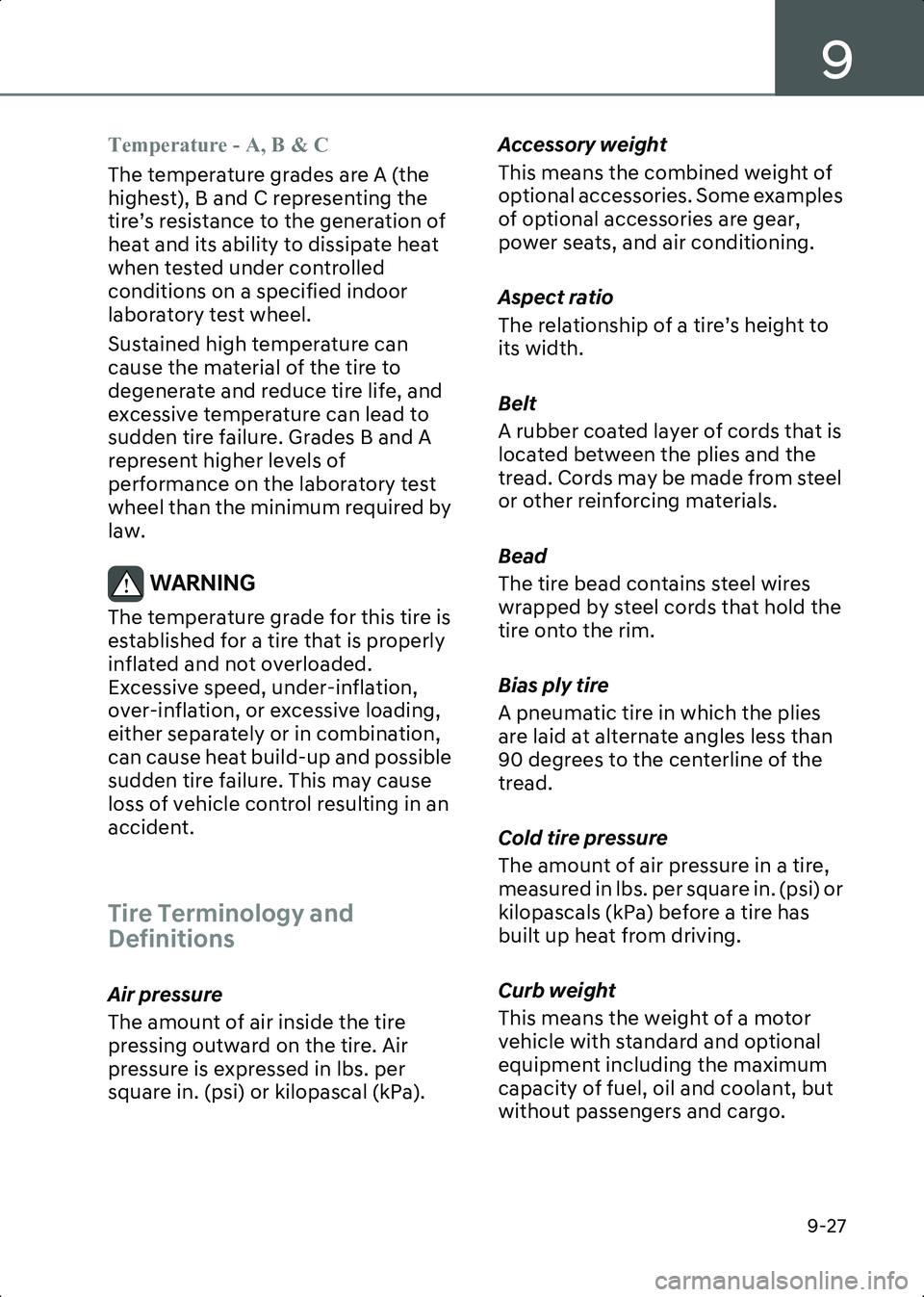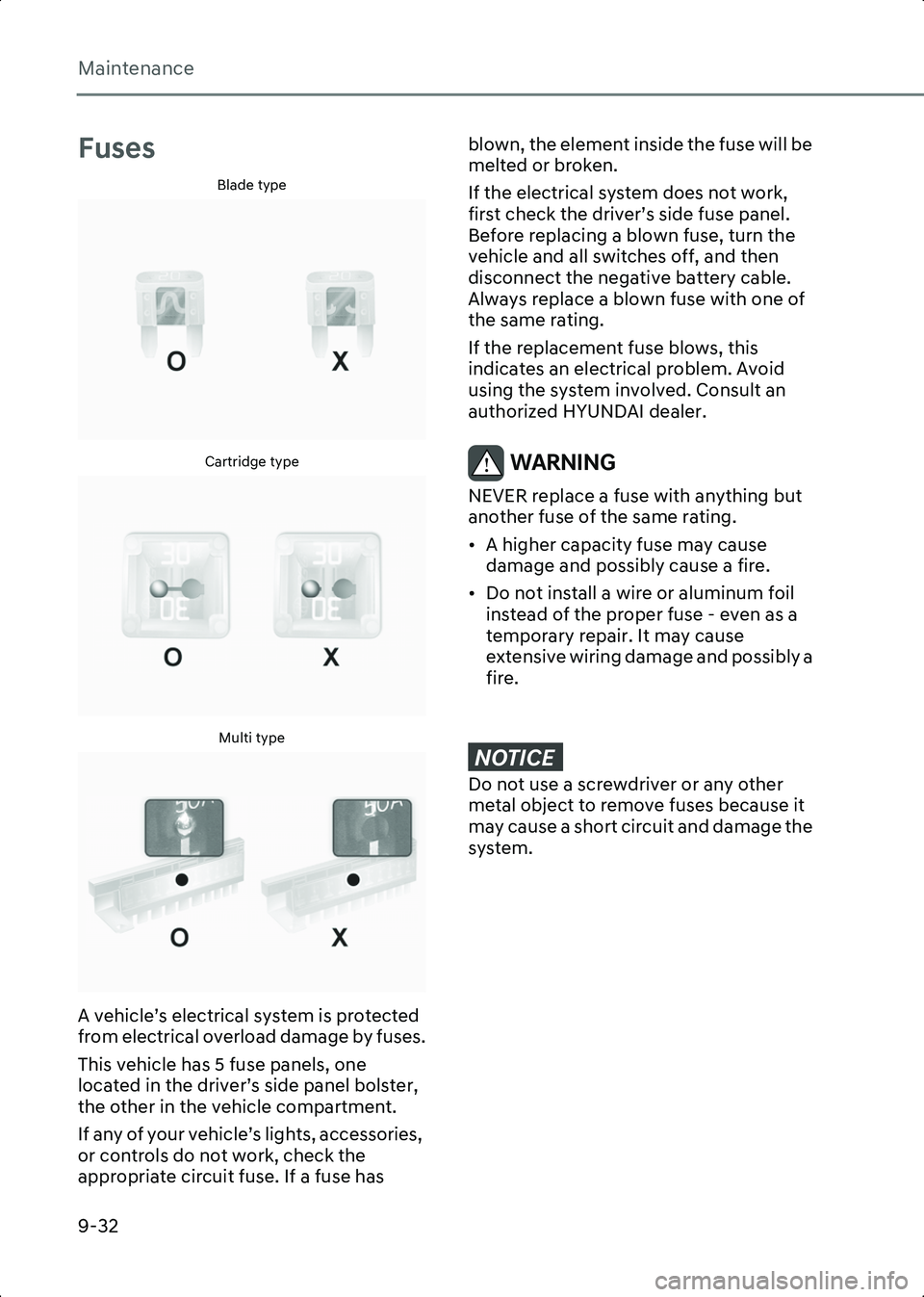Page 535 of 582

9
9-19
• If the vehicle is not going to be used for an extended time, disconnect the
battery cables.
Battery Capacity Label
OLMB073072
Information The actual battery label in the vehicle may
differ from the illustration.
1. CMF60L-DIN(12 v): The HYUNDAI model name of battery
2. 60Ah (20 HR): The nominal capacity (in Ampere hours)
3. 550 A: The cold-test current in amperes by SAE / EN
4. RC 92 min: The nominal reserve capacity (in minutes)
Battery Recharging
By battery charger
Your vehicle has a maintenance-free,
calcium-based battery.
• If the battery becomes discharged over a short time (because, for example, the
headlights or interior lights were left on
while the vehicle was not in use),
recharge it by slow charging (trickle) for
10 hours.
• If the battery gradually discharges because of high electrical load while the vehicle is being used, recharge it at
20-30 A for two hours.
WARNING Always follow these instructions when
recharging your vehicle’s battery to avoid
the risk of SERIOUS INJURY or DEATH
from explosions or acid burns:
• Before performing maintenance or
recharging the battery, turn off all
accessories and stop the vehicle.
• Keep all flames, sparks, or smoking materials away from the battery.
• Always work outdoors or in an area with plenty of ventilation.
• Wear eye protection when checking the battery during charging.
• The battery must be removed from the vehicle and placed in a well ventilated
area.
• Watch the battery during charging, and stop or reduce the charging rate if the
battery cells begin boiling violently.
• Remove the negative battery cable first and install it last when the battery is
disconnected. Disconnect the battery
charger in the following order:
1. Turn off the battery charger main switch.
2. Unhook the negative clamp from the negative battery terminal.
3. Unhook the positive clamp from the positive battery terminal.
By jump starting
After a jump start from a good battery,
drive the vehicle for 20-30 minutes
before it is shutoff. The vehicle may not
restart if you shut it off before the battery
had a chance to adequately recharge. For
more information, refer to the
“JumpStarting” section in chapter 8 for
more information on jump starting
procedures.
Hyundai_CE_en_US.book Page 19
Page 543 of 582

9
9-27
Temperature - A, B & C
The temperature grades are A (the
highest), B and C representing the
tire’s resistance to the generation of
heat and its ability to dissipate heat
when tested under controlled
conditions on a specified indoor
laboratory test wheel.
Sustained high temperature can
cause the material of the tire to
degenerate and reduce tire life, and
excessive temperature can lead to
sudden tire failure. Grades B and A
represent higher levels of
performance on the laboratory test
wheel than the minimum required by
law.
WARNING The temperature grade for this tire is
established for a tire that is properly
inflated and not overloaded.
Excessive speed, under-inflation,
over-inflation, or excessive loading,
either separately or in combination,
can cause heat build-up and possible
sudden tire failure. This may cause
loss of vehicle control resulting in an
accident.
Tire Terminology and
Definitions
Air pressure
The amount of air inside the tire
pressing outward on the tire. Air
pressure is expressed in lbs. per
square in. (psi) or kilopascal (kPa).Accessory weight
This means the combined weight of
optional accessories. Some examples
of optional accessories are gear,
power seats, and air conditioning.
Aspect ratio
The relationship of a tire’s height to
its width.
Belt
A rubber coated layer of cords that is
located between the plies and the
tread. Cords may be made from steel
or other reinforcing materials.
Bead
The tire bead contains steel wires
wrapped by steel cords that hold the
tire onto the rim.
Bias ply tire
A pneumatic tire in which the plies
are laid at alternate angles less than
90 degrees to the centerline of the
tread.
Cold tire pressure
The amount of air pressure in a tire,
measured in lbs. per square in. (psi) or
kilopascals (kPa) before a tire has
built up heat from driving.
Curb weight
This means the weight of a motor
vehicle with standard and optional
equipment including the maximum
capacity of fuel, oil and coolant, but
without passengers and cargo.
Hyundai_CE_en_US.book Page 27
Page 548 of 582

Maintenance
9-32
Fuses
Blade type
B9005601Cartridge type
B9005602Multi type
B9005603
A vehicle’s electrical system is protected
from electrical overload damage by fuses.
This vehicle has 5 fuse panels, one
located in the driver’s side panel bolster,
the other in the vehicle compartment.
If any of your vehicle’s lights, accessories,
or controls do not work, check the
appropriate circuit fuse. If a fuse has blown, the element inside the fuse will be
melted or broken.
If the electrical system does not work,
first check the driver’s side fuse panel.
Before replacing a blown fuse, turn the
vehicle and all switches off, and then
disconnect the negative battery cable.
Always replace a blown fuse with one of
the same rating.
If the replacement fuse blows, this
indicates an electrical problem. Avoid
using the system involved. Consult an
authorized HYUNDAI dealer.
WARNING NEVER replace a fuse with anything but
another fuse of the same rating.
• A higher capacity fuse may cause
damage and possibly cause a fire.
• Do not install a wire or aluminum foil instead of the proper fuse - even as a
temporary repair. It may cause
extensive wiring damage and possibly a
fire.
NOTICE���'�R���Q�R�W���X�V�H���D���V�F�U�H�Z�G�U�L�Y�H�U���R�U���D�Q�\���R�W�K�H�U��
�P�H�W�D�O���R�E�M�H�F�W���W�R���U�H�P�R�Y�H���I�X�V�H�V���E�H�F�D�X�V�H���L�W��
�P�D�\���F�D�X�V�H���D���V�K�R�U�W���F�L�U�F�X�L�W���D�Q�G���G�D�P�D�J�H���W�K�H��
�V�\�V�W�H�P��
��
Hyundai_CE_en_US.book Page 32